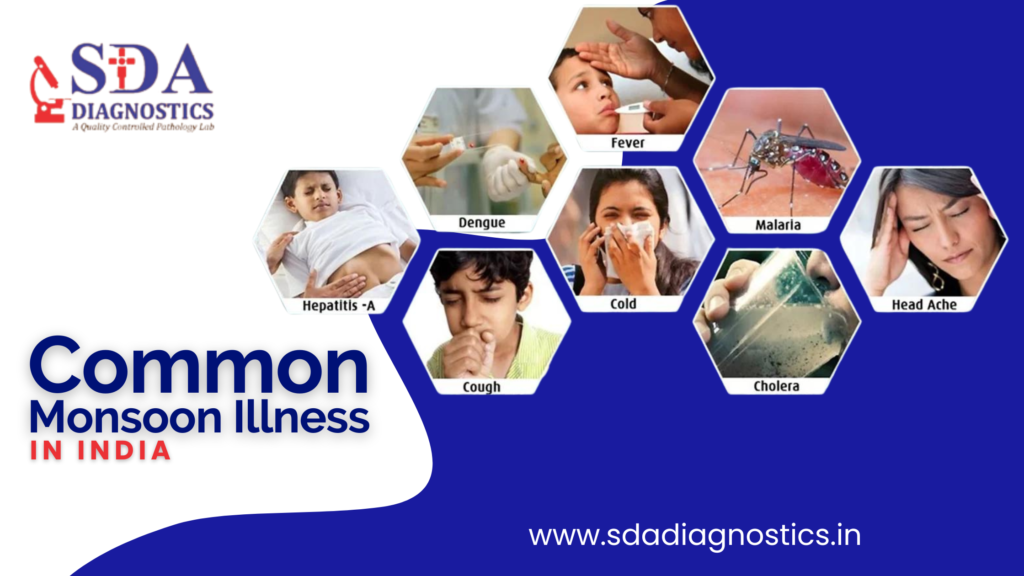Common Monsoon Illnesses in india

The monsoon season in India brings much-needed relief from the scorching summer heat. However, it also ushers in a host of health challenges. Increased humidity, waterlogging, and the proliferation of insects contribute to the spread of various illnesses. In this blog, Dr. Sonal Dhingra will discuss some of the most common monsoon illnesses in India and how to prevent and manage them.
1. Dengue Fever
Dengue fever is one of the most common monsoon illnesses in India. It is transmitted by the Aedes mosquito, which breeds in stagnant water. Symptoms include high fever, severe headache, pain behind the eyes, joint and muscle pain, rash, and bleeding tendencies. To prevent dengue, it is crucial to eliminate stagnant water sources around your home, use mosquito repellents, and sleep under mosquito nets.
2. Malaria
Malaria is another mosquito-borne disease that spikes during the monsoon season. It is caused by the Plasmodium parasite, transmitted through the bite of the Anopheles mosquito. Symptoms include fever with chills, sweating, headache, nausea, and vomiting. Preventive measures are similar to those for dengue, including avoiding mosquito bites and ensuring there are no breeding grounds for mosquitoes around you.
3. Chikungunya
Chikungunya is a viral disease transmitted by the Aedes mosquito. It shares many symptoms with dengue, such as high fever, severe joint pain, rash, and fatigue. Joint pain can persist for weeks or even months. Preventing chikungunya involves avoiding mosquito bites and taking steps to reduce mosquito breeding sites.
4. Leptospirosis
Leptospirosis is a bacterial infection that spreads through water contaminated with the urine of infected animals. During the monsoon, flooding increases the risk of contamination. Symptoms include high fever, severe headache, muscle pain, chills, redness in the eyes, and vomiting. To prevent leptospirosis, avoid walking through flooded areas and ensure that you have protective footwear if you must wade through water.
5. Gastroenteritis
Gastroenteritis, or stomach flu, is an inflammation of the stomach and intestines caused by bacterial or viral infections. Contaminated food and water are common sources of infection during the monsoon. Symptoms include diarrhea, vomiting, abdominal pain, and fever. To prevent gastroenteritis, drink clean, boiled water, eat freshly prepared food, and maintain good hygiene.
6. Typhoid Fever
Typhoid fever is a bacterial infection caused by Salmonella typhi. It spreads through contaminated food and water. Symptoms include prolonged high fever, weakness, stomach pain, headache, and loss of appetite. Preventive measures include drinking only clean water, avoiding street food, and practicing good hand hygiene.
7. Hepatitis A
Hepatitis A is a viral infection that affects the liver. It spreads through consuming contaminated food and water. Symptoms include fever, fatigue, jaundice (yellowing of the skin and eyes), loss of appetite, nausea, and abdominal discomfort. To prevent Hepatitis A, ensure safe drinking water, maintain good sanitation, and get vaccinated if recommended.
8. Common Cold and Flu
The sudden changes in temperature and increased humidity during the monsoon make people more susceptible to respiratory infections like the common cold and flu. Symptoms include runny or stuffy nose, sore throat, cough, body aches, and fever. Preventive measures include maintaining good personal hygiene, avoiding close contact with infected individuals, and boosting your immune system with a healthy diet.
9. Fungal Infections
Increased humidity during the monsoon creates an environment where fungal infections can thrive. Common areas affected include the skin, nails, and scalp. Symptoms include itching, redness, and skin lesions. To prevent fungal infections, keep your skin dry, wear breathable clothing, and avoid walking barefoot in damp areas.
Prevention and Care
Taking preventive measures is crucial to avoid these common monsoon illnesses. Here are some general tips:
- Ensure there is no stagnant water around your home.
- Use mosquito repellents and nets.
- Drink only boiled or filtered water.
- Avoid eating street food and ensure food is cooked thoroughly.
- Maintain good personal hygiene.
- Wear protective clothing and footwear.
In case of illness, seek medical attention promptly. Early diagnosis and treatment can prevent complications.
For accurate diagnosis and comprehensive healthcare services, you can visit SDA Diagnostics Meerut. Their experienced medical professionals can provide the necessary care and guidance to keep you healthy during the monsoon season.
Stay safe and enjoy the rains by taking the necessary precautions to protect yourself and your loved ones from these common monsoon illnesses.
FAQs:
What are the most common symptoms to watch out for during the monsoon season?
During the monsoon season, common symptoms to be aware of include high fever, chills, joint and muscle pain, severe headaches, rash, nausea, vomiting, stomach pain, diarrhea, and jaundice. If you experience any of these symptoms, it’s important to seek medical attention promptly.
How can I protect myself from mosquito-borne diseases during the monsoon?
To protect yourself from mosquito-borne diseases like dengue, malaria, and chikungunya:
- Use mosquito repellents on exposed skin.
- Wear long-sleeved shirts and pants.
- Sleep under mosquito nets.
- Keep your surroundings clean and free of stagnant water where mosquitoes can breed.
- Use screens on windows and doors to keep mosquitoes out.
What precautions should I take to avoid waterborne diseases in the monsoon?
To avoid waterborne diseases such as typhoid, gastroenteritis, and leptospirosis:
- Drink only boiled or bottled water.
- Avoid consuming ice from unknown sources.
- Ensure food is cooked thoroughly and avoid street food.
- Practice good personal hygiene, including regular hand washing.
- Wear protective footwear if you need to walk through floodwaters.
